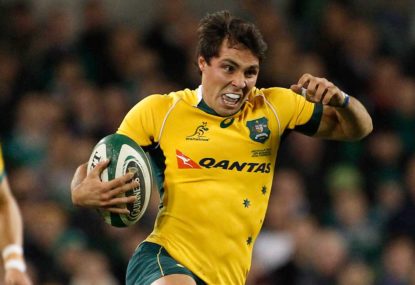While the Wallabies suffered another loss against Ireland, it was their best performance on this tour.
In all areas, apart from the scrum and defusing the high ball, the Wallabies made progress.
Michael Cheika is very good with his man management – he showed that at Leinster and at the Waratahs. This week we saw his influence on the Wallabies start to have some impact.
Down by 17 points after just 16 minutes, many Wallaby teams in the recent past would have dropped their heads a little or panicked. But Cheika is clearly instilling some mental toughness into this team, which is a real positive.
Set piece
The lineout performance this week was really good, both in attack and defence, with the only blemish being one throw not straight from Saia Fainga’a. The Wallabies pressured the Irish lineout, which forced four losses for them, although that result is bolstered by the fact that Rory Best gives the opposition plenty of help in this area with his throwing.
The scrum was solid in the first half but don’t get carried away with the performance. This was an Irish scrum that got absolutely destroyed by the Springboks two weeks ago. The Wallabies managed to get on top in a few scrums but had nothing like the dominance South Africa were able to achieve.
England will be a big challenge at scrum time this week, and then we’ll see if there has been any real progress.
It was interesting to see that the Wallaby coaches have moved Will Skelton to the loosehead side of the scrum. It’s a bit like deciding a player can’t tackle very well so he should be hidden in the defensive line!
The scrum fell away quite badly late in the first half and through the second half, even before the replacements were made in the tight five. The scrum at 34:55 was the first sign of trouble when Sekope Kepu folded in under pressure and the tight head to Ireland at 59:45 was nothing short of dreadful by the Wallabies, with Kepu’s side being decimated.
The crucial scrum penalty at 74:40 was correct as James Slipper lost his bind and rolled in under pressure and it proved very costly. Slipper had scrummaged well all match and been dominant on his side but this week he was the prop disadvantaged by having Skelton packing behind him.
Defence
The biggest improvement from the Wallabies in this match was in the intensity of the defence. Not only did players show more urgency to get into position and increase their line speed, but they were also much more physical.
The Wallabies missed 14 tackles (which is an acceptable level) but other players scrambling to cover for their team mates restricted Ireland to only three clean line breaks. That’s a good sign that the attitude is right.
Matt Toomua was key – his attack is good but his leadership in defence makes the Wallabies aggressive defence structure function so much better.
However, despite a better performance from the Wallabies in defence, Ireland played a very smart game tactically that exposed a couple of real weaknesses in the Wallabies defensive structure.
The first involves taking the flyhalf out of the defensive line by having them play as a second fullback. Note that this applied to both Bernard Foley and Quade Cooper so it’s not an attack on the defensive capabilities of either player.
The issue with that positioning is that neither player is good enough under the high ball as a fullback. Ireland went in with a plan to drop high balls on top of Foley and he couldn’t compete with the taller Irish jumpers, who also had the advantage of moving forward rather than being quite static under the high ball. The second fullback really needs to be a taller, back-three player who can compete for the high balls.
The plan was clearly to kick away from Israel Folau but even if a team kicks high balls to Folau it is a good way to contain him because even if he wins the ball in the air he’s not likely to have much room to break free once he lands.
Yes, Ireland kicked a lot but it was a tactical change up as they don’t usually kick that much. It was obviously a tactic to specifically target the Wallaby structure.
The other thing that a lot of kicking does is to force the two fullbacks the Wallabies are using to play deeper if they want to be in position to take the ball. With the halfback acting as a sweeper to cover chip kicks in behind the rushing defensive line, the Wallabies only have 12 players in the front line.
To cover for that shortage, they have to defend in a very narrow structure, leaving the last player in the opposition attacking line effectively unmarked.
Here’s the first example when Johnny Sexton landed his pinpoint kick for Simon Zebo to score. You can see that the Wallabies are effectively only defending the middle section of the field between the 15 metres lines, inviting trouble out wide.
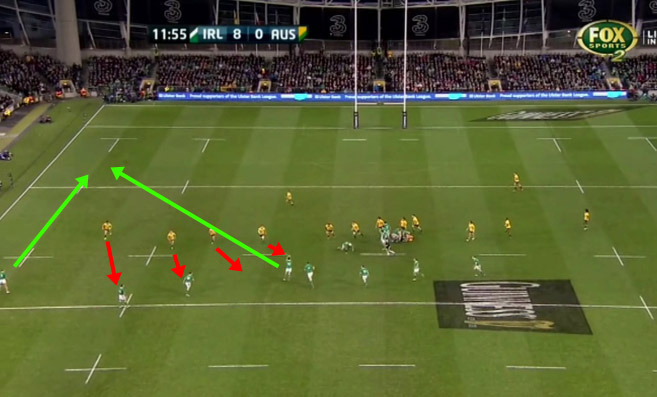
Here’s another example where again the Wallabies are defending with a very narrow line. You can see two fullbacks for the Wallabies and both Irish wingers (circled) have no defender within 10 metres of them.

To try and stop the ball getting out to these players in space, the Wallabies have their defensive ends rush up to try and tackle the second man in on either side before they can pass the ball.
However, if they don’t get to that player they have to turn and chase as Henry Speight had to in this example, with the ball (circled) already having been passed outside him.
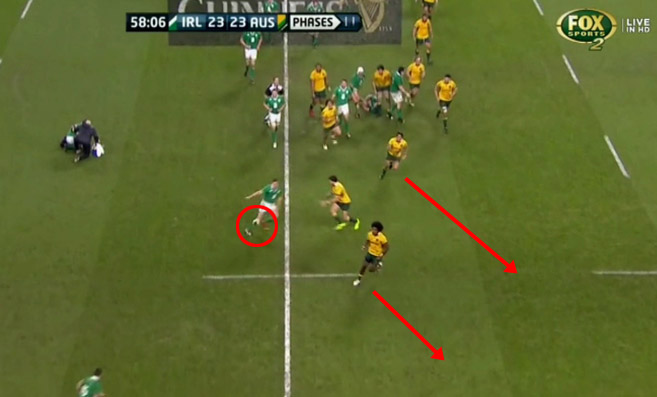
And here’s another example where this time the Irish didn’t move the ball wide to the free man outside Speight.

It may be that Speight is still learning the system but exactly the same space was evident in the matches against Wales and France when he wasn’t playing so it’s the system, not the players, that need to change.
The Irish played a very smart game tactically with their kicking but they probably kicked a little too much. They missed a number of opportunities to run the ball and it won’t take long for opposing coaches to come up with plans to exploit these holes.
I’m sure the England coaches won’t have missed this so I expect we’ll see a lot of high balls early from England this week to force the Wallaby fullbacks deep before they then start to run the ball out wide.
Attack
The Wallabies were more potent in attack this week and the second try that Nick Phipps scored was an absolute beauty.
The Wallabies used the ball in attack much better than Ireland, who stuck to their game plan of giving the ball to the Wallabies and then containing them.
The Wallabies had eight clean breaks to Ireland’s three according to ESPN. The passing and interchanges between players was a feature, apart from those two really poor drops by Benn Robinson and Michael Hooper late in the match.
However, the ‘chaos’ attack once again failed to build the momentum the Wallabies need. In only 19 per cent of attacking sequences could the Wallabies put together consecutive phases where they got the ball over the gain line, up from only 11 per cent against France but still nowhere near good enough. This number was 26 per cent against Wales.
As Greg Clarke said in commentary, “There’s some continuity here but they’re not really going anywhere.”
A more positive number is the fact that they got the ball over the gain line on 41 per cent of their phases. This is up from 26 per cent against France and 35 per cent against Wales.
There is now some recognition that the Wallabies game plan needs to be re-worked a little to allow them to win against the top teams, rather than just get close. This will involve some additional structure in attack and more use of kicking as an attacking weapon.
In comments after the match Bernard Foley said, “We’ve got to develop a game plan that suits Test rugby. The plan that we used at the Waratahs doesn’t work here, it’s a different level. The teams we’re coming up against are a lot better, so we have to develop some variation.”
John Eales and Nathan Sharpe went into a little more detail in their discussion on Fox Sports after the game.
Sharpe talked about the base pattern required, saying, “It helps if you have a default pattern to go to, so when there’s not a lot at stake or you’re under pressure, everyone in the team knows a really simple pattern of play that they can go back to and find some comfort within that…
“And if they can execute that really well then it makes the game so much easier to launch from – it’s not just running across field looking for numbers. If they can find some sort of pattern that they can get some familiarity with, then that gives them confidence when times are tough.”
Eales agreed and said the current pattern needed some changes saying, “I think the default pattern of play Cheika wants is to just keep attacking isn’t it and to keep that high tempo of game going.
“You’re right, they need to construct something to maybe bring it in a bit tighter before they can spin it a bit wider.”
Sharpe concluded the discussion by saying “The ball is going side to side a lot for Australia at the moment. I just wonder whether they need to vary their point of attack a little bit.
“Teams are now starting to understand that Australia’s going to run the ball from anywhere, they’re going to throw the ball to the edges every time.”
Now I know that both Eales and Sharpe are Queenslanders, so some of you will want to disregard their views, but they are on to something. For those of you who don’t want to take on board what they said, you’ll just have to look at Foley’s comments.
One of the other issues with the ‘fling it wide’ default pattern is that you risk too many turnovers in the wide channels when your support players can’t get to the breakdown fast enough. The Irish obviously knew what the Wallabies default pattern has been and swooped on any player caught in the wide channels.
Here’s the first example where the Irish have two players in position to achieve a turnover when none of the Wallaby support players have even arrived.
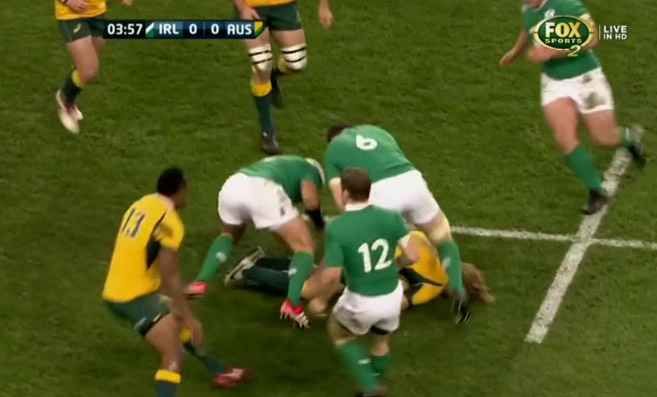
In the final attacking sequence the Wallabies had in the match the Irish again got two players into the ruck before the first Wallaby supporter even arrived on the scene.
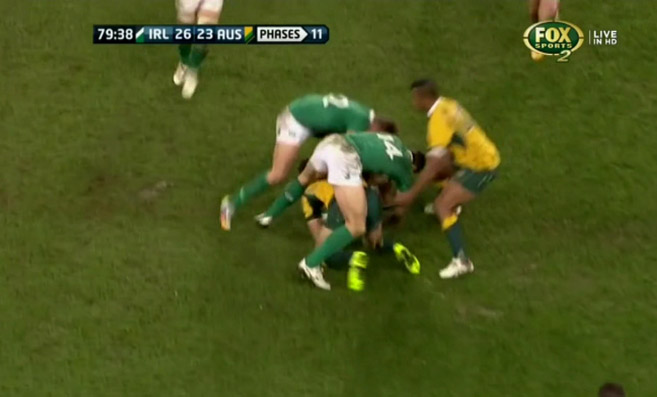
Playing a little tighter would give the Wallabies a much better chance of getting more supporters around the ball carrier to avoid these soft turnovers.
The final example I want to show you regarding the default ‘fling it wide’ pattern came when Tommy Bowe intercepted the ball for Ireland’s second try.
The opportunity Phipps saw out wide was set up by a break from Folau, backed up by a strong carry down the right side of the field by Ben McCalman. Up to the point it was very good from the Wallabies.
However, having broken the line the Wallabies needed immediate options to carry on the attack and further disrupt the Irish defence. But when Phipps came up looking for a runner there was no one to be found. He had to run across field looking for an option before Bernard Foley arrived as a one-out option.
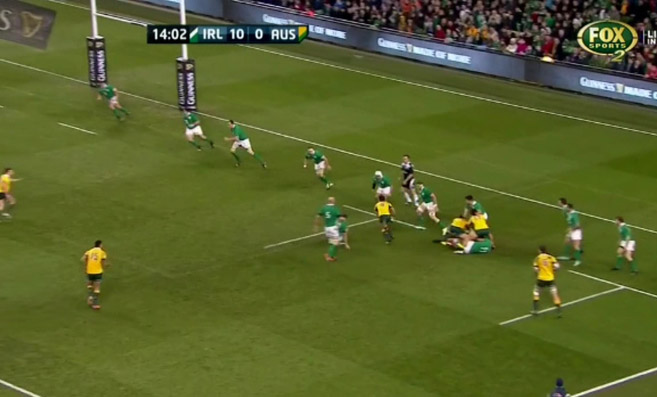
Where were all the potential ball carriers? They were all on the left side of the field waiting for the ball to get to them.
Phipps chose not to pass to Foley but to throw a pass that was ripe for intercept. Look at the four forwards standing in the middle of the field waiting for the glory ball rather than getting in closer to the ruck and doing the hard work required.

On the next phase Phipps again threw the potential intercept pass trying to get the ball to Tevita Kuridrani. Only this time Bowe snapped it up and scored a crucial try for Ireland.
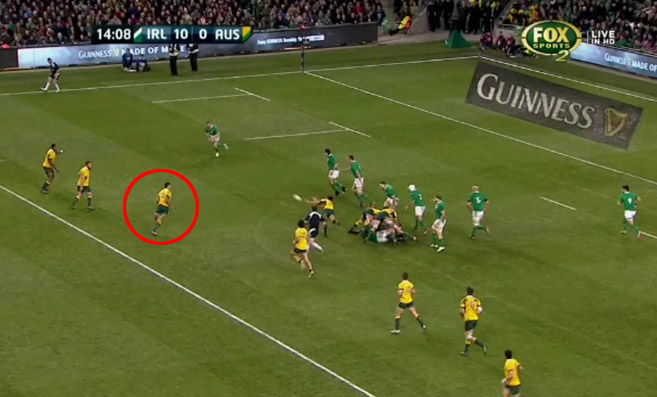
As you can see I’ve highlighted another option Phipps could have taken rather than ‘flinging it wide’. That’s Folau circled with a lock and tighthead prop in front of him.
With no risk Phipps could choose the tighter option and I’d back Folau to get outside Mike Ross any day. Even if Bowe comes in on Folau, Slipper and Kuridrani would have been there in support to take a pass from Folau.
Instead Phipps tried the risky wide option. Now that’s not totally his fault – he’s under instructions to play like this.
When we look at that pass from end on we find the other two Wallabies who weren’t in close enough to support – Speight and Hooper (circled) competing to receive the ball to run into the corner.
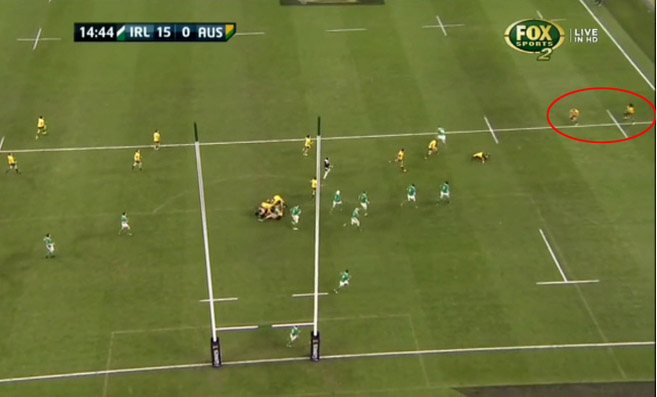
Fortunately there now seems to be some recognition that the ‘chaos’ attack style and default ‘fling it wide’ pattern with limited kicking is not the best way to deal with Test rugby.





























































































